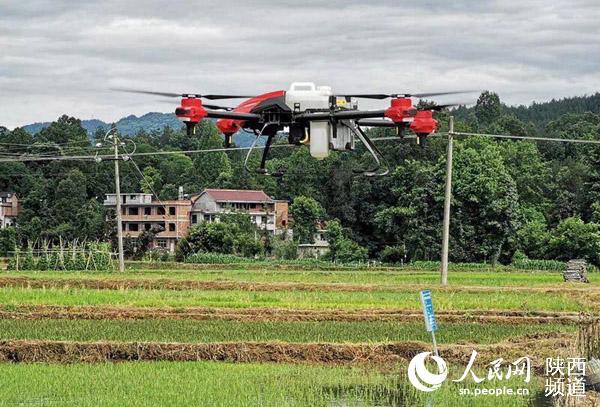

Agricultural machineries are playing an increasingly significant role in China’s grain production, as more and more “powerful weapons” such as automated seedling cultivation machines, transplanters, agricultural drones and combined harvesters are playing their part in farming activities.
The rate of mechanization in the plowing, sowing and harvesting of major crops throughout the country is now over 70 percent.

A drone sprays pesticide over paddy fields in Hanzhong, northwest China’s Shaanxi province. (Photo/People’s Daily Online)
New technologies such as the Internet of Things (IoT), Beidou navigation and big data are being applied in the agriculture sector, driving the development of China’s smart agriculture and bringing benefits to farmers.
Gao Yifeng, a member of the agricultural cooperative in Beishao village of Dingzhou city in north China’s Hebei province, was seen checking the growth of corns on his farmland with his mobile phone during his break from working on a production line making dried noodles.
“Villagers are now using mobile phones to grow crops. Thanks to the agricultural IoT, we secured a bumper harvest this year,” Gao said, adding that they can log into a website with their phones to monitor 12 types of real-time data such as the light, temperature and humidity of their farmlands.
In the past, villagers had to spend half a day to check the growth of crops in the farmlands, Gao said, noting that locals now can do the same thing at home through the video monitoring function on an information platform on their phones.
The village began to apply the agricultural IoT last year. “Various kinds of sensors were installed in the farmlands to collect information and transmit data to the platform. After a comprehensive analysis, this data will assist farmers in their farming activities,” said Wu Yongshan, an agricultural technician at the bureau of agriculture and rural affairs of Dingzhou.
“Some farmers sought excessive irrigation in the past for convenience. Now we do not need to irrigate too much at a time, and we can replenish water and fertilizer at any time according to the monitoring results, which saves labor and water and increases the crop yield,” Gao said.
In the first half of this year, when monitoring data showed that the moisture content of soil in Gao’s farmlands was too low, the information platform immediately issued an early warning to him. After receiving the information on his mobile phone, Gao promptly supplied water to his triticale, ensuring the normal growth of the crop.
“The IoT not only collects real-time data but also saves data. For example, consumers can track the quality of raw materials of dried noodles and triticale flour produced by the agricultural cooperative in Beishao village by scanning QR codes on the packages,” Wu said, adding that the agricultural IoT technology further ensures food safety.
At present, the village has piloted automatic irrigation, which can be controlled on a mobile phone according to the IoT-based information tips, in about 0.67 hectares of farmlands. The village planted about 66.7 hectares of corn this year.
“Although cooperative members still need to enter the pump room and press the buttons to irrigate most of the arable land in our village, we will expand trials to more farmlands,” said Wu Kaixun, Party head of the village.
In Sihong county, east China’s Jiangsu province, automated seedling cultivation machines are applied to reduce labor intensity for farmers and to improve the quality and efficiency of the cultivation of rice seedlings. The machines can also reduce the cost of per mu (0.07 hectares) by 60 to 100 yuan.
In Huaxian county, central China’s Henan province, with the ability to save more than 90 percent of water and over 30 percent of pesticide, drones are being used to spray pesticide in farmlands to reduce cost and improve efficiency. This year, the county has sprayed pesticide in all of its 6,667 hectares of high-standard farmlands.
In Woyang county, east China’s Anhui province, tractors equipped with self-driving technology based on the Beidou navigation system are used to improve the efficiency of farming. The system can also be applied to drones, harvesters and other agricultural machineries, improving the grain output by 5 percent and reducing fuel consumption by about 10 percent.
Machineries have greatly reduced labor intensity and improved the efficiency of grain production, which saves in costs and helps farmers across China grow crops in a more relaxed and scientific manner.
 Fire brigade in Shanghai holds group wedding
Fire brigade in Shanghai holds group wedding Tourists enjoy ice sculptures in Datan Town, north China
Tourists enjoy ice sculptures in Datan Town, north China Sunset scenery of Dayan Pagoda in Xi'an
Sunset scenery of Dayan Pagoda in Xi'an Tourists have fun at scenic spot in Nanlong Town, NW China
Tourists have fun at scenic spot in Nanlong Town, NW China Harbin attracts tourists by making best use of ice in winter
Harbin attracts tourists by making best use of ice in winter In pics: FIS Alpine Ski Women's World Cup Slalom
In pics: FIS Alpine Ski Women's World Cup Slalom Black-necked cranes rest at reservoir in Lhunzhub County, Lhasa
Black-necked cranes rest at reservoir in Lhunzhub County, Lhasa China's FAST telescope will be available to foreign scientists in April
China's FAST telescope will be available to foreign scientists in April "She power" plays indispensable role in poverty alleviation
"She power" plays indispensable role in poverty alleviation Top 10 world news events of People's Daily in 2020
Top 10 world news events of People's Daily in 2020 Top 10 China news events of People's Daily in 2020
Top 10 China news events of People's Daily in 2020 Top 10 media buzzwords of 2020
Top 10 media buzzwords of 2020 Year-ender:10 major tourism stories of 2020
Year-ender:10 major tourism stories of 2020 No interference in Venezuelan issues
No interference in Venezuelan issues
 Biz prepares for trade spat
Biz prepares for trade spat
 Broadcasting Continent
Broadcasting Continent Australia wins Chinese CEOs as US loses
Australia wins Chinese CEOs as US loses